Management Accounting Report: Profitability and Strategic Decisions
VerifiedAdded on 2019/09/16
|14
|2594
|364
Report
AI Summary
This management accounting report examines various aspects of a company's financial performance and strategic decision-making. It begins by calculating monthly profit, considering sales revenue, manufacturing costs (direct materials, labor, overhead), and marketing expenses. The report then analyzes factors crucial for accepting orders, including profit margins, offer value, brand benefits, and long-term implications. It evaluates a long-term government contract, assessing its impact on brand image, organizational value, and sustainable profit. Furthermore, the report explores the foreign market, determining the minimum selling price and break-even analysis. Finally, it assesses offers from outside suppliers, comparing in-house production costs with outsourcing options and analyzing the financial impact of different supplier offers, ultimately aiming to maximize profitability and achieve long-term goals. The report uses financial calculations to support its conclusions.
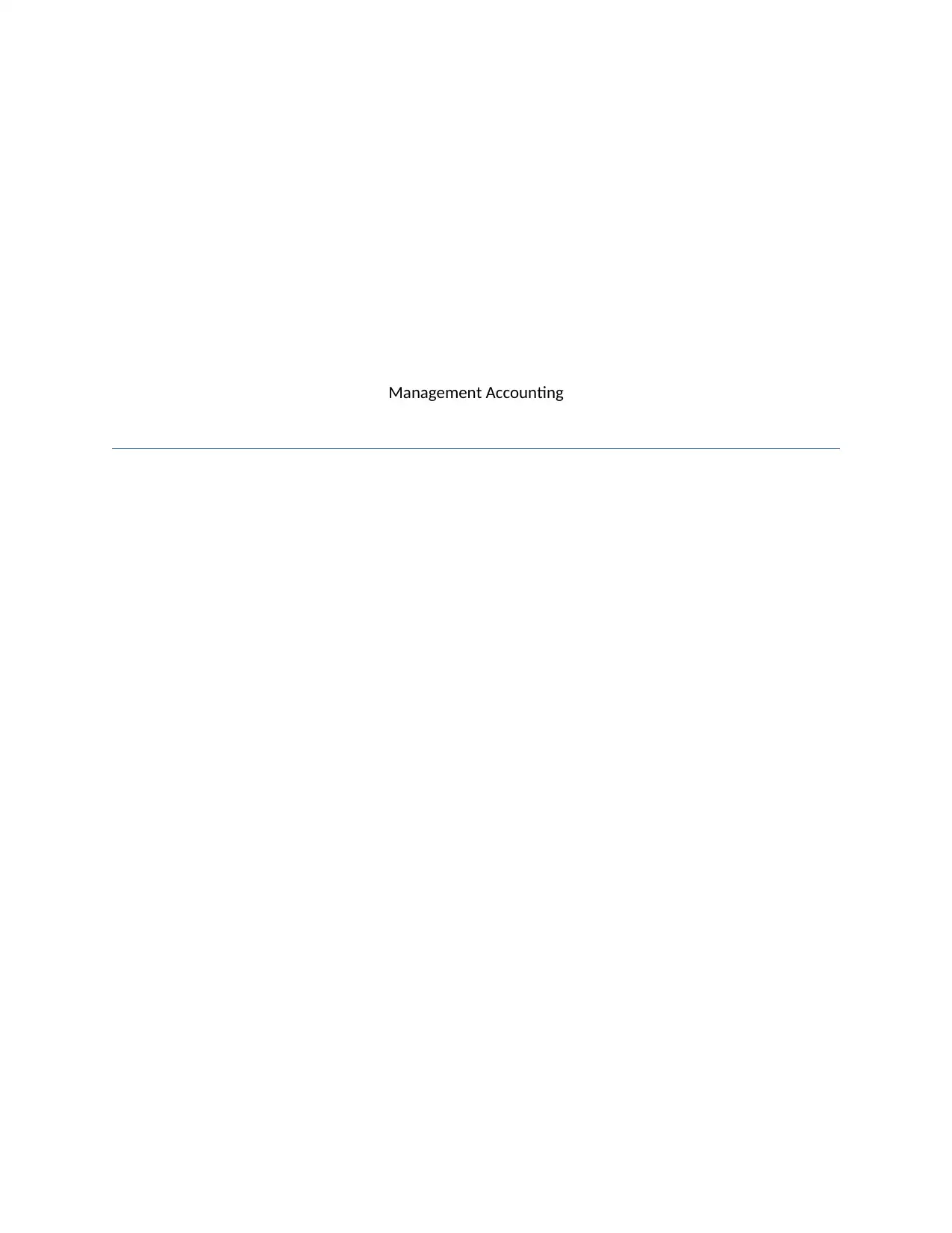
Management Accounting
Paraphrase This Document
Need a fresh take? Get an instant paraphrase of this document with our AI Paraphraser
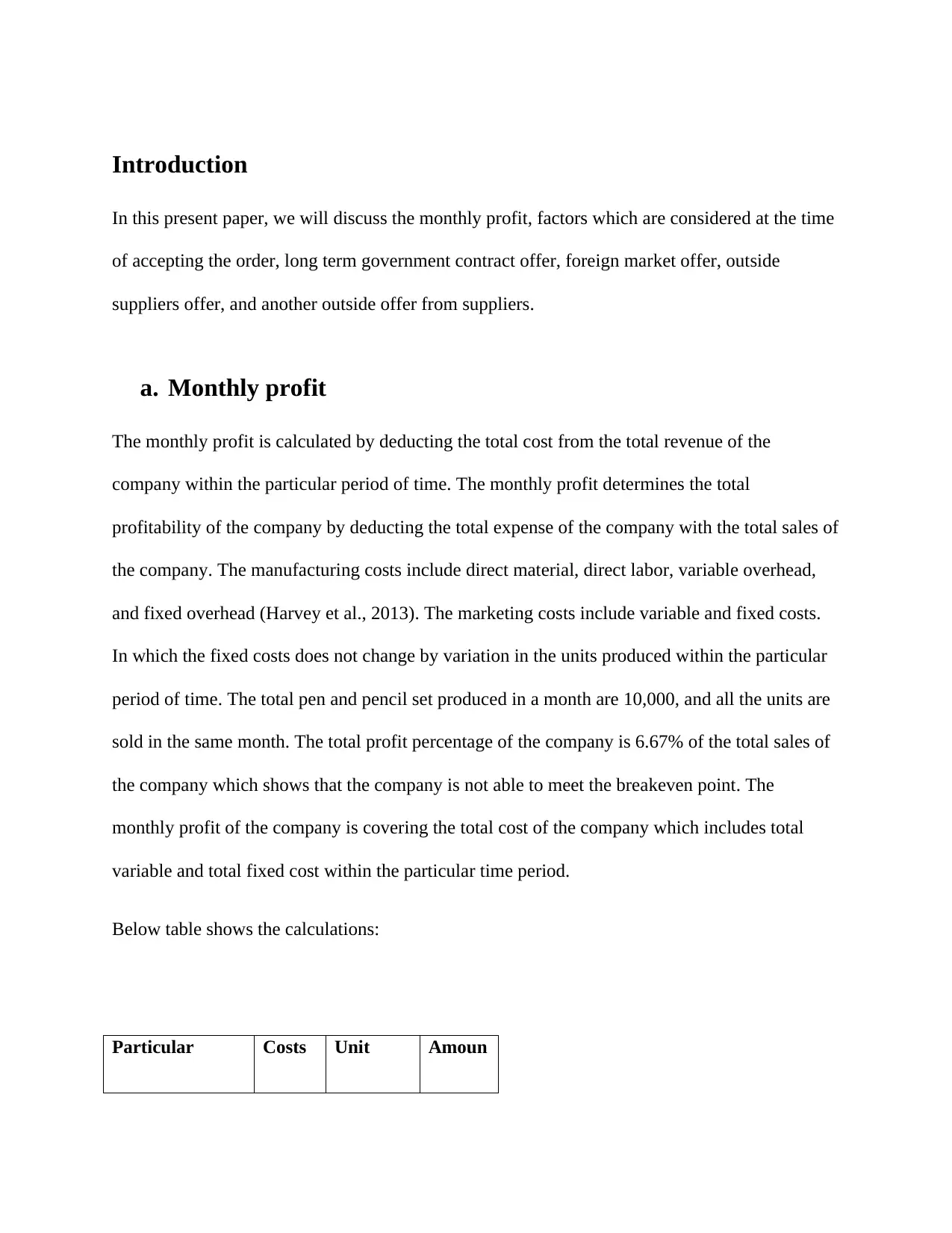
Introduction
In this present paper, we will discuss the monthly profit, factors which are considered at the time
of accepting the order, long term government contract offer, foreign market offer, outside
suppliers offer, and another outside offer from suppliers.
a. Monthly profit
The monthly profit is calculated by deducting the total cost from the total revenue of the
company within the particular period of time. The monthly profit determines the total
profitability of the company by deducting the total expense of the company with the total sales of
the company. The manufacturing costs include direct material, direct labor, variable overhead,
and fixed overhead (Harvey et al., 2013). The marketing costs include variable and fixed costs.
In which the fixed costs does not change by variation in the units produced within the particular
period of time. The total pen and pencil set produced in a month are 10,000, and all the units are
sold in the same month. The total profit percentage of the company is 6.67% of the total sales of
the company which shows that the company is not able to meet the breakeven point. The
monthly profit of the company is covering the total cost of the company which includes total
variable and total fixed cost within the particular time period.
Below table shows the calculations:
Particular Costs Unit Amoun
In this present paper, we will discuss the monthly profit, factors which are considered at the time
of accepting the order, long term government contract offer, foreign market offer, outside
suppliers offer, and another outside offer from suppliers.
a. Monthly profit
The monthly profit is calculated by deducting the total cost from the total revenue of the
company within the particular period of time. The monthly profit determines the total
profitability of the company by deducting the total expense of the company with the total sales of
the company. The manufacturing costs include direct material, direct labor, variable overhead,
and fixed overhead (Harvey et al., 2013). The marketing costs include variable and fixed costs.
In which the fixed costs does not change by variation in the units produced within the particular
period of time. The total pen and pencil set produced in a month are 10,000, and all the units are
sold in the same month. The total profit percentage of the company is 6.67% of the total sales of
the company which shows that the company is not able to meet the breakeven point. The
monthly profit of the company is covering the total cost of the company which includes total
variable and total fixed cost within the particular time period.
Below table shows the calculations:
Particular Costs Unit Amoun
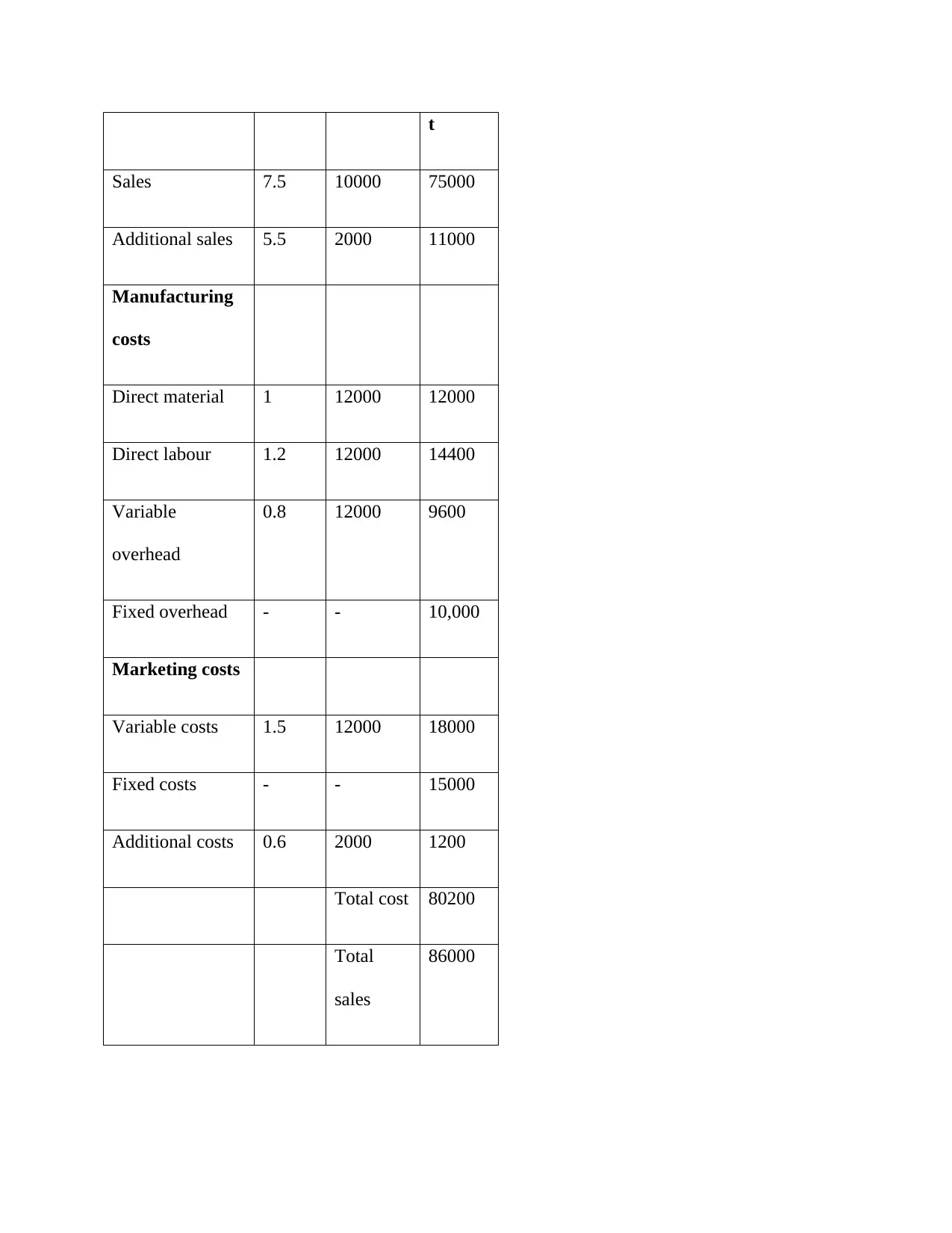
t
Sales 7.5 10000 75000
Additional sales 5.5 2000 11000
Manufacturing
costs
Direct material 1 12000 12000
Direct labour 1.2 12000 14400
Variable
overhead
0.8 12000 9600
Fixed overhead - - 10,000
Marketing costs
Variable costs 1.5 12000 18000
Fixed costs - - 15000
Additional costs 0.6 2000 1200
Total cost 80200
Total
sales
86000
Sales 7.5 10000 75000
Additional sales 5.5 2000 11000
Manufacturing
costs
Direct material 1 12000 12000
Direct labour 1.2 12000 14400
Variable
overhead
0.8 12000 9600
Fixed overhead - - 10,000
Marketing costs
Variable costs 1.5 12000 18000
Fixed costs - - 15000
Additional costs 0.6 2000 1200
Total cost 80200
Total
sales
86000
⊘ This is a preview!⊘
Do you want full access?
Subscribe today to unlock all pages.

Trusted by 1+ million students worldwide
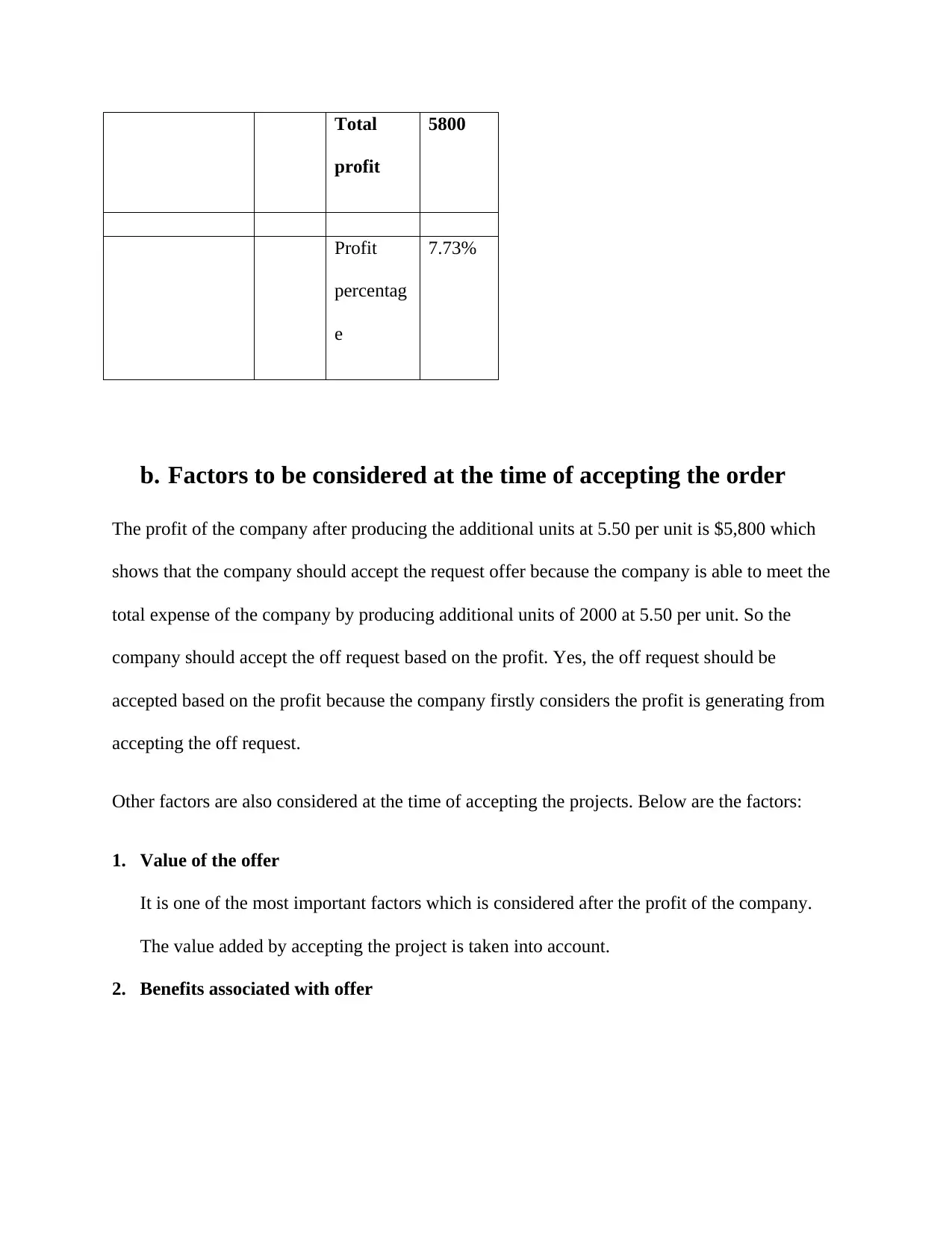
Total
profit
5800
Profit
percentag
e
7.73%
b. Factors to be considered at the time of accepting the order
The profit of the company after producing the additional units at 5.50 per unit is $5,800 which
shows that the company should accept the request offer because the company is able to meet the
total expense of the company by producing additional units of 2000 at 5.50 per unit. So the
company should accept the off request based on the profit. Yes, the off request should be
accepted based on the profit because the company firstly considers the profit is generating from
accepting the off request.
Other factors are also considered at the time of accepting the projects. Below are the factors:
1. Value of the offer
It is one of the most important factors which is considered after the profit of the company.
The value added by accepting the project is taken into account.
2. Benefits associated with offer
profit
5800
Profit
percentag
e
7.73%
b. Factors to be considered at the time of accepting the order
The profit of the company after producing the additional units at 5.50 per unit is $5,800 which
shows that the company should accept the request offer because the company is able to meet the
total expense of the company by producing additional units of 2000 at 5.50 per unit. So the
company should accept the off request based on the profit. Yes, the off request should be
accepted based on the profit because the company firstly considers the profit is generating from
accepting the off request.
Other factors are also considered at the time of accepting the projects. Below are the factors:
1. Value of the offer
It is one of the most important factors which is considered after the profit of the company.
The value added by accepting the project is taken into account.
2. Benefits associated with offer
Paraphrase This Document
Need a fresh take? Get an instant paraphrase of this document with our AI Paraphraser
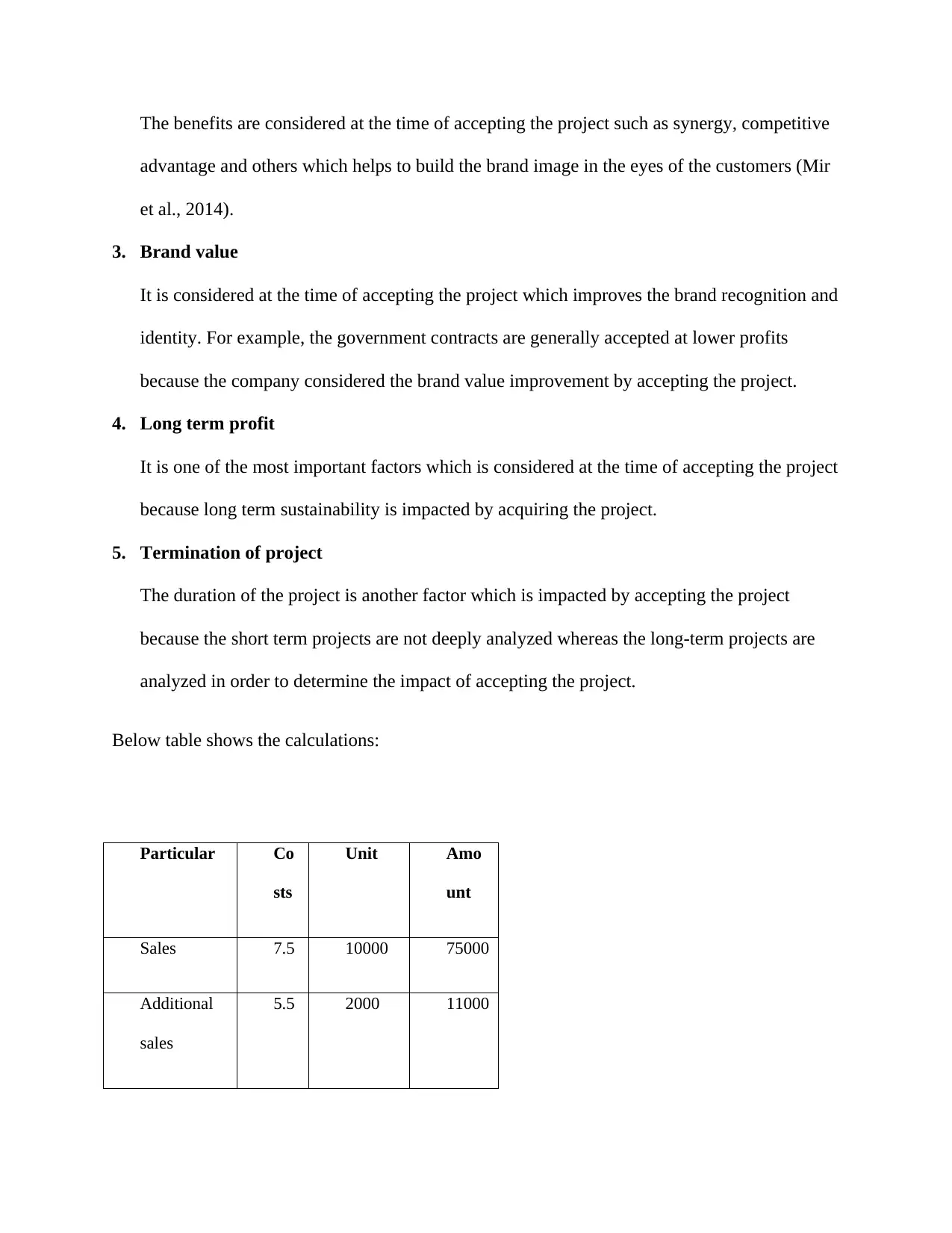
The benefits are considered at the time of accepting the project such as synergy, competitive
advantage and others which helps to build the brand image in the eyes of the customers (Mir
et al., 2014).
3. Brand value
It is considered at the time of accepting the project which improves the brand recognition and
identity. For example, the government contracts are generally accepted at lower profits
because the company considered the brand value improvement by accepting the project.
4. Long term profit
It is one of the most important factors which is considered at the time of accepting the project
because long term sustainability is impacted by acquiring the project.
5. Termination of project
The duration of the project is another factor which is impacted by accepting the project
because the short term projects are not deeply analyzed whereas the long-term projects are
analyzed in order to determine the impact of accepting the project.
Below table shows the calculations:
Particular Co
sts
Unit Amo
unt
Sales 7.5 10000 75000
Additional
sales
5.5 2000 11000
advantage and others which helps to build the brand image in the eyes of the customers (Mir
et al., 2014).
3. Brand value
It is considered at the time of accepting the project which improves the brand recognition and
identity. For example, the government contracts are generally accepted at lower profits
because the company considered the brand value improvement by accepting the project.
4. Long term profit
It is one of the most important factors which is considered at the time of accepting the project
because long term sustainability is impacted by acquiring the project.
5. Termination of project
The duration of the project is another factor which is impacted by accepting the project
because the short term projects are not deeply analyzed whereas the long-term projects are
analyzed in order to determine the impact of accepting the project.
Below table shows the calculations:
Particular Co
sts
Unit Amo
unt
Sales 7.5 10000 75000
Additional
sales
5.5 2000 11000
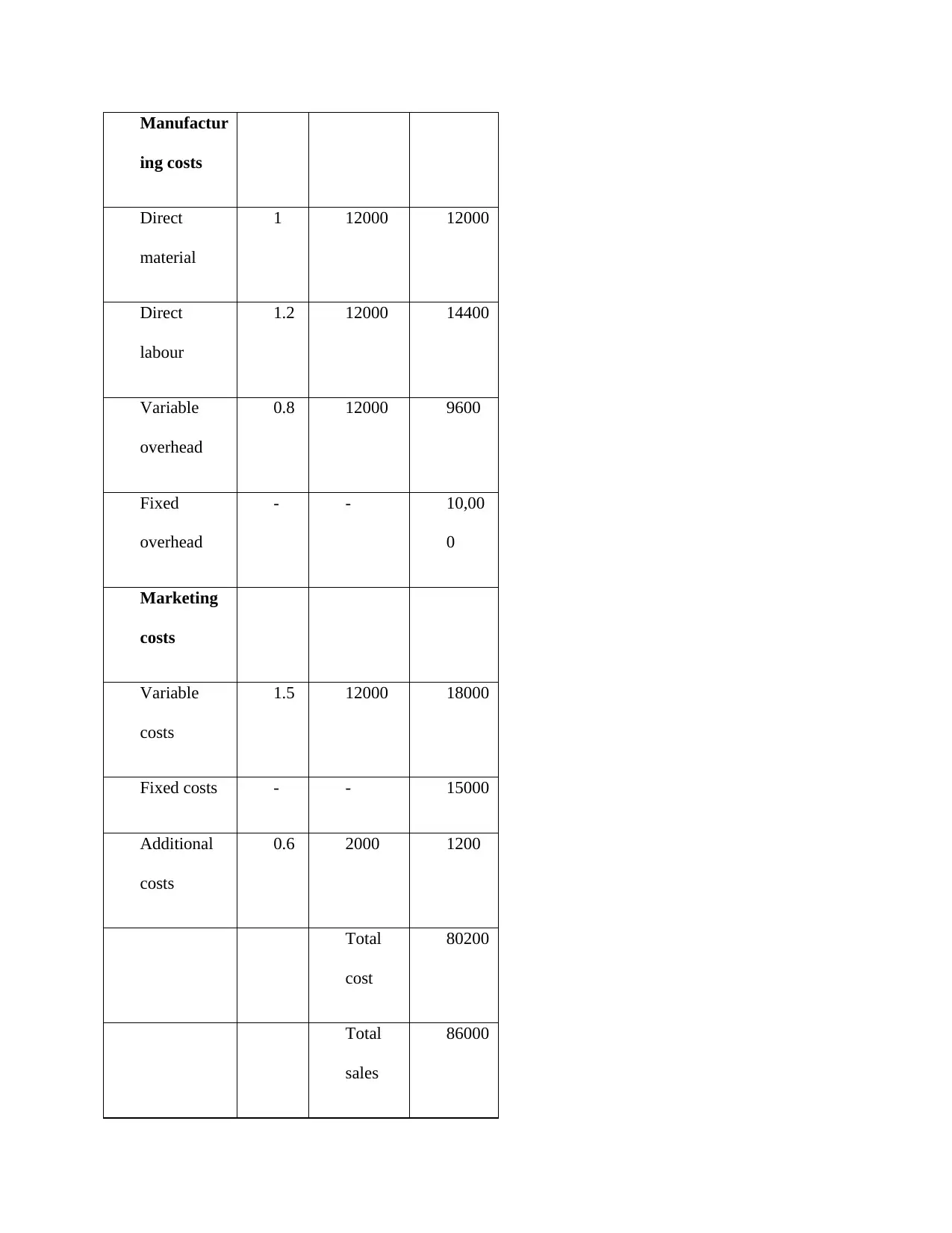
Manufactur
ing costs
Direct
material
1 12000 12000
Direct
labour
1.2 12000 14400
Variable
overhead
0.8 12000 9600
Fixed
overhead
- - 10,00
0
Marketing
costs
Variable
costs
1.5 12000 18000
Fixed costs - - 15000
Additional
costs
0.6 2000 1200
Total
cost
80200
Total
sales
86000
ing costs
Direct
material
1 12000 12000
Direct
labour
1.2 12000 14400
Variable
overhead
0.8 12000 9600
Fixed
overhead
- - 10,00
0
Marketing
costs
Variable
costs
1.5 12000 18000
Fixed costs - - 15000
Additional
costs
0.6 2000 1200
Total
cost
80200
Total
sales
86000
⊘ This is a preview!⊘
Do you want full access?
Subscribe today to unlock all pages.

Trusted by 1+ million students worldwide
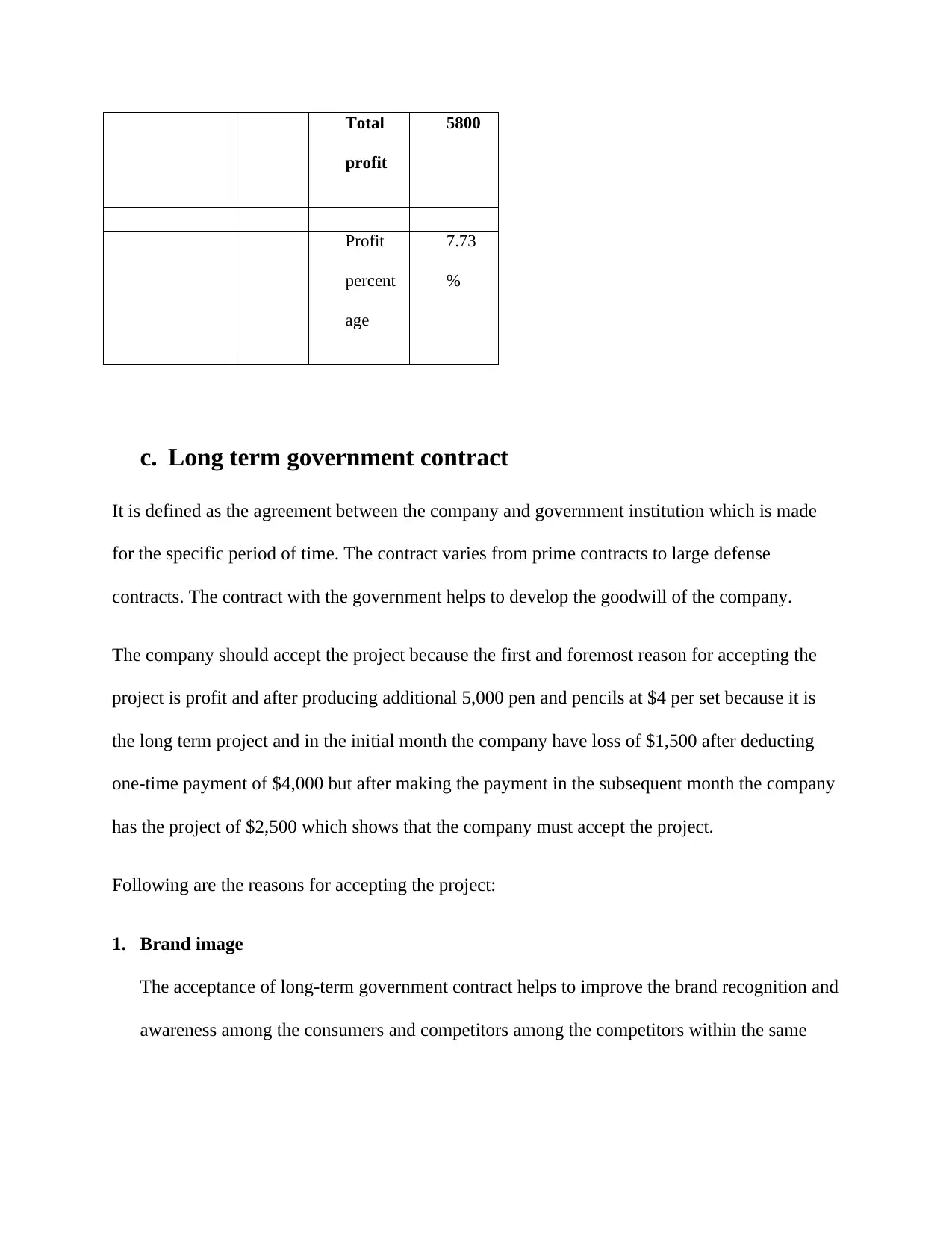
Total
profit
5800
Profit
percent
age
7.73
%
c. Long term government contract
It is defined as the agreement between the company and government institution which is made
for the specific period of time. The contract varies from prime contracts to large defense
contracts. The contract with the government helps to develop the goodwill of the company.
The company should accept the project because the first and foremost reason for accepting the
project is profit and after producing additional 5,000 pen and pencils at $4 per set because it is
the long term project and in the initial month the company have loss of $1,500 after deducting
one-time payment of $4,000 but after making the payment in the subsequent month the company
has the project of $2,500 which shows that the company must accept the project.
Following are the reasons for accepting the project:
1. Brand image
The acceptance of long-term government contract helps to improve the brand recognition and
awareness among the consumers and competitors among the competitors within the same
profit
5800
Profit
percent
age
7.73
%
c. Long term government contract
It is defined as the agreement between the company and government institution which is made
for the specific period of time. The contract varies from prime contracts to large defense
contracts. The contract with the government helps to develop the goodwill of the company.
The company should accept the project because the first and foremost reason for accepting the
project is profit and after producing additional 5,000 pen and pencils at $4 per set because it is
the long term project and in the initial month the company have loss of $1,500 after deducting
one-time payment of $4,000 but after making the payment in the subsequent month the company
has the project of $2,500 which shows that the company must accept the project.
Following are the reasons for accepting the project:
1. Brand image
The acceptance of long-term government contract helps to improve the brand recognition and
awareness among the consumers and competitors among the competitors within the same
Paraphrase This Document
Need a fresh take? Get an instant paraphrase of this document with our AI Paraphraser
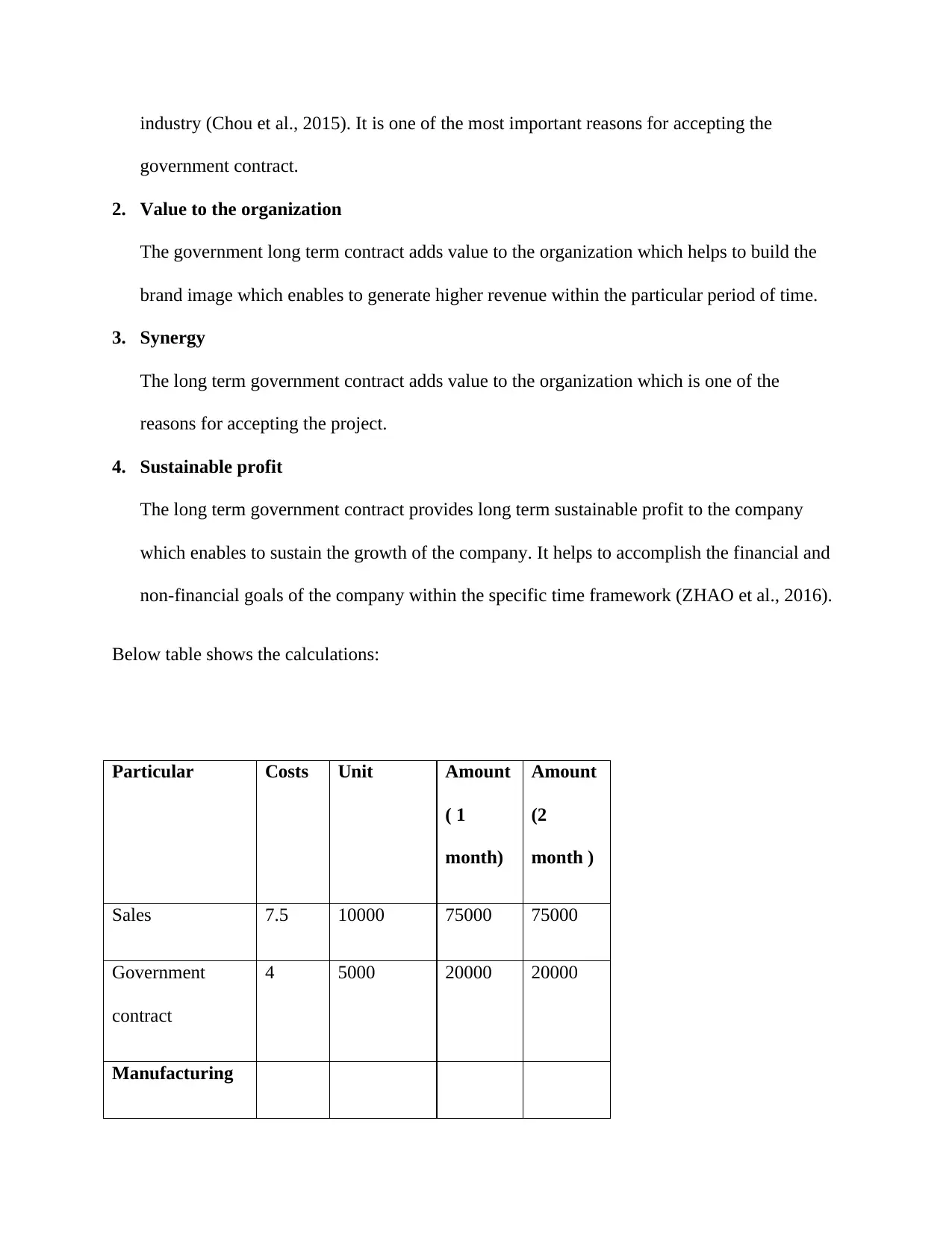
industry (Chou et al., 2015). It is one of the most important reasons for accepting the
government contract.
2. Value to the organization
The government long term contract adds value to the organization which helps to build the
brand image which enables to generate higher revenue within the particular period of time.
3. Synergy
The long term government contract adds value to the organization which is one of the
reasons for accepting the project.
4. Sustainable profit
The long term government contract provides long term sustainable profit to the company
which enables to sustain the growth of the company. It helps to accomplish the financial and
non-financial goals of the company within the specific time framework (ZHAO et al., 2016).
Below table shows the calculations:
Particular Costs Unit Amount
( 1
month)
Amount
(2
month )
Sales 7.5 10000 75000 75000
Government
contract
4 5000 20000 20000
Manufacturing
government contract.
2. Value to the organization
The government long term contract adds value to the organization which helps to build the
brand image which enables to generate higher revenue within the particular period of time.
3. Synergy
The long term government contract adds value to the organization which is one of the
reasons for accepting the project.
4. Sustainable profit
The long term government contract provides long term sustainable profit to the company
which enables to sustain the growth of the company. It helps to accomplish the financial and
non-financial goals of the company within the specific time framework (ZHAO et al., 2016).
Below table shows the calculations:
Particular Costs Unit Amount
( 1
month)
Amount
(2
month )
Sales 7.5 10000 75000 75000
Government
contract
4 5000 20000 20000
Manufacturing
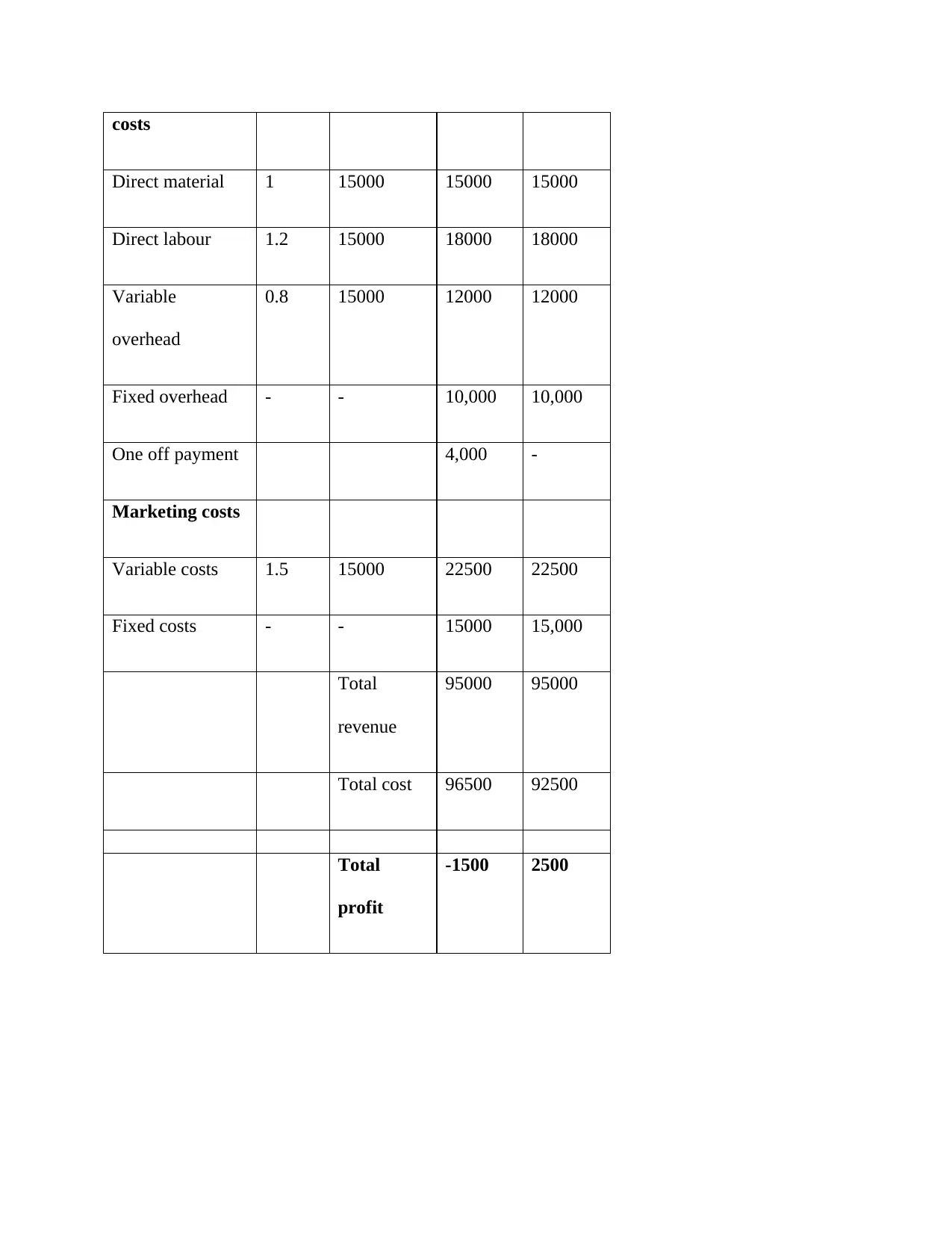
costs
Direct material 1 15000 15000 15000
Direct labour 1.2 15000 18000 18000
Variable
overhead
0.8 15000 12000 12000
Fixed overhead - - 10,000 10,000
One off payment 4,000 -
Marketing costs
Variable costs 1.5 15000 22500 22500
Fixed costs - - 15000 15,000
Total
revenue
95000 95000
Total cost 96500 92500
Total
profit
-1500 2500
Direct material 1 15000 15000 15000
Direct labour 1.2 15000 18000 18000
Variable
overhead
0.8 15000 12000 12000
Fixed overhead - - 10,000 10,000
One off payment 4,000 -
Marketing costs
Variable costs 1.5 15000 22500 22500
Fixed costs - - 15000 15,000
Total
revenue
95000 95000
Total cost 96500 92500
Total
profit
-1500 2500
⊘ This is a preview!⊘
Do you want full access?
Subscribe today to unlock all pages.

Trusted by 1+ million students worldwide
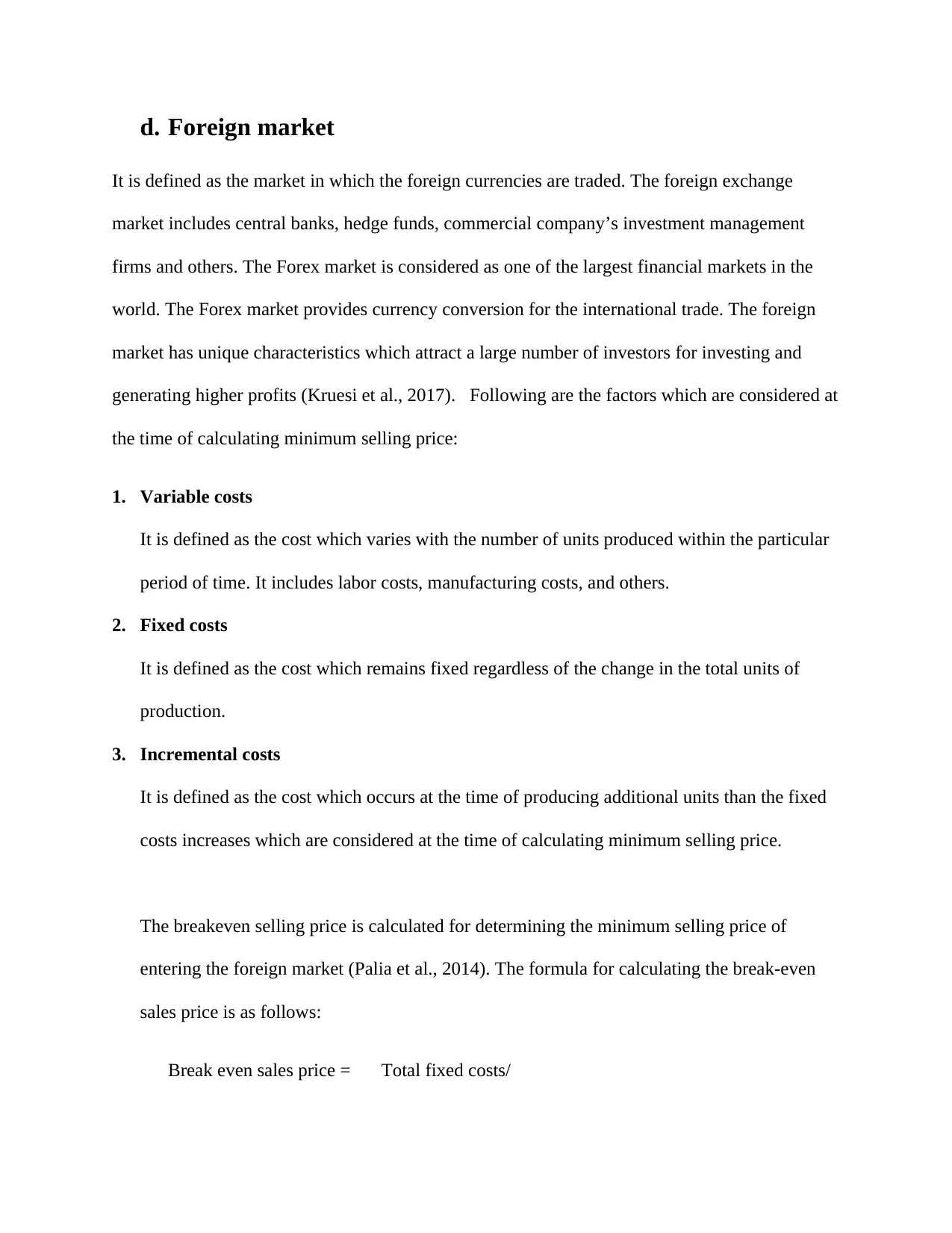
d. Foreign market
It is defined as the market in which the foreign currencies are traded. The foreign exchange
market includes central banks, hedge funds, commercial company’s investment management
firms and others. The Forex market is considered as one of the largest financial markets in the
world. The Forex market provides currency conversion for the international trade. The foreign
market has unique characteristics which attract a large number of investors for investing and
generating higher profits (Kruesi et al., 2017). Following are the factors which are considered at
the time of calculating minimum selling price:
1. Variable costs
It is defined as the cost which varies with the number of units produced within the particular
period of time. It includes labor costs, manufacturing costs, and others.
2. Fixed costs
It is defined as the cost which remains fixed regardless of the change in the total units of
production.
3. Incremental costs
It is defined as the cost which occurs at the time of producing additional units than the fixed
costs increases which are considered at the time of calculating minimum selling price.
The breakeven selling price is calculated for determining the minimum selling price of
entering the foreign market (Palia et al., 2014). The formula for calculating the break-even
sales price is as follows:
Break even sales price = Total fixed costs/
It is defined as the market in which the foreign currencies are traded. The foreign exchange
market includes central banks, hedge funds, commercial company’s investment management
firms and others. The Forex market is considered as one of the largest financial markets in the
world. The Forex market provides currency conversion for the international trade. The foreign
market has unique characteristics which attract a large number of investors for investing and
generating higher profits (Kruesi et al., 2017). Following are the factors which are considered at
the time of calculating minimum selling price:
1. Variable costs
It is defined as the cost which varies with the number of units produced within the particular
period of time. It includes labor costs, manufacturing costs, and others.
2. Fixed costs
It is defined as the cost which remains fixed regardless of the change in the total units of
production.
3. Incremental costs
It is defined as the cost which occurs at the time of producing additional units than the fixed
costs increases which are considered at the time of calculating minimum selling price.
The breakeven selling price is calculated for determining the minimum selling price of
entering the foreign market (Palia et al., 2014). The formula for calculating the break-even
sales price is as follows:
Break even sales price = Total fixed costs/
Paraphrase This Document
Need a fresh take? Get an instant paraphrase of this document with our AI Paraphraser
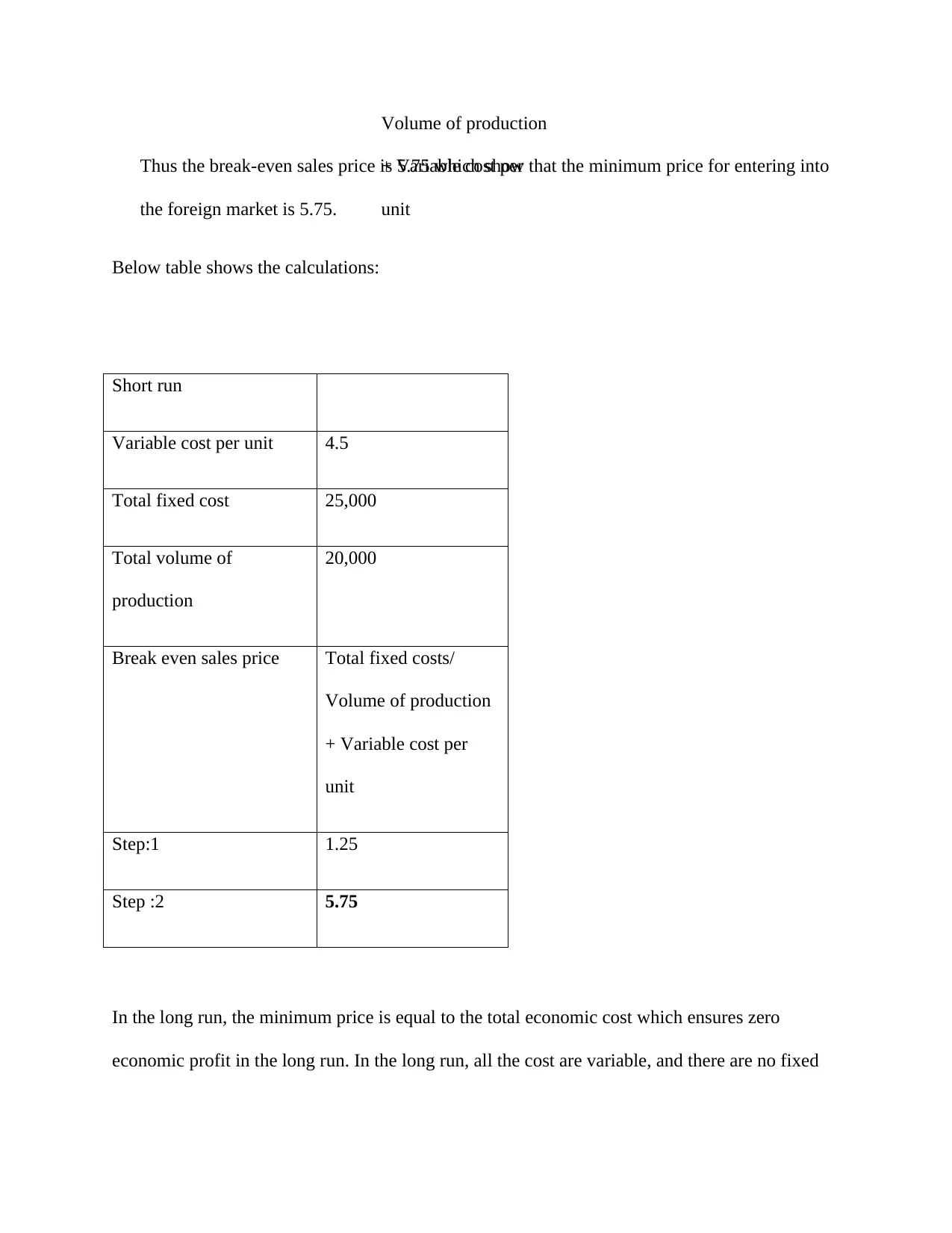
Volume of production
+ Variable cost per
unit
Thus the break-even sales price is 5.75 which show that the minimum price for entering into
the foreign market is 5.75.
Below table shows the calculations:
Short run
Variable cost per unit 4.5
Total fixed cost 25,000
Total volume of
production
20,000
Break even sales price Total fixed costs/
Volume of production
+ Variable cost per
unit
Step:1 1.25
Step :2 5.75
In the long run, the minimum price is equal to the total economic cost which ensures zero
economic profit in the long run. In the long run, all the cost are variable, and there are no fixed
+ Variable cost per
unit
Thus the break-even sales price is 5.75 which show that the minimum price for entering into
the foreign market is 5.75.
Below table shows the calculations:
Short run
Variable cost per unit 4.5
Total fixed cost 25,000
Total volume of
production
20,000
Break even sales price Total fixed costs/
Volume of production
+ Variable cost per
unit
Step:1 1.25
Step :2 5.75
In the long run, the minimum price is equal to the total economic cost which ensures zero
economic profit in the long run. In the long run, all the cost are variable, and there are no fixed
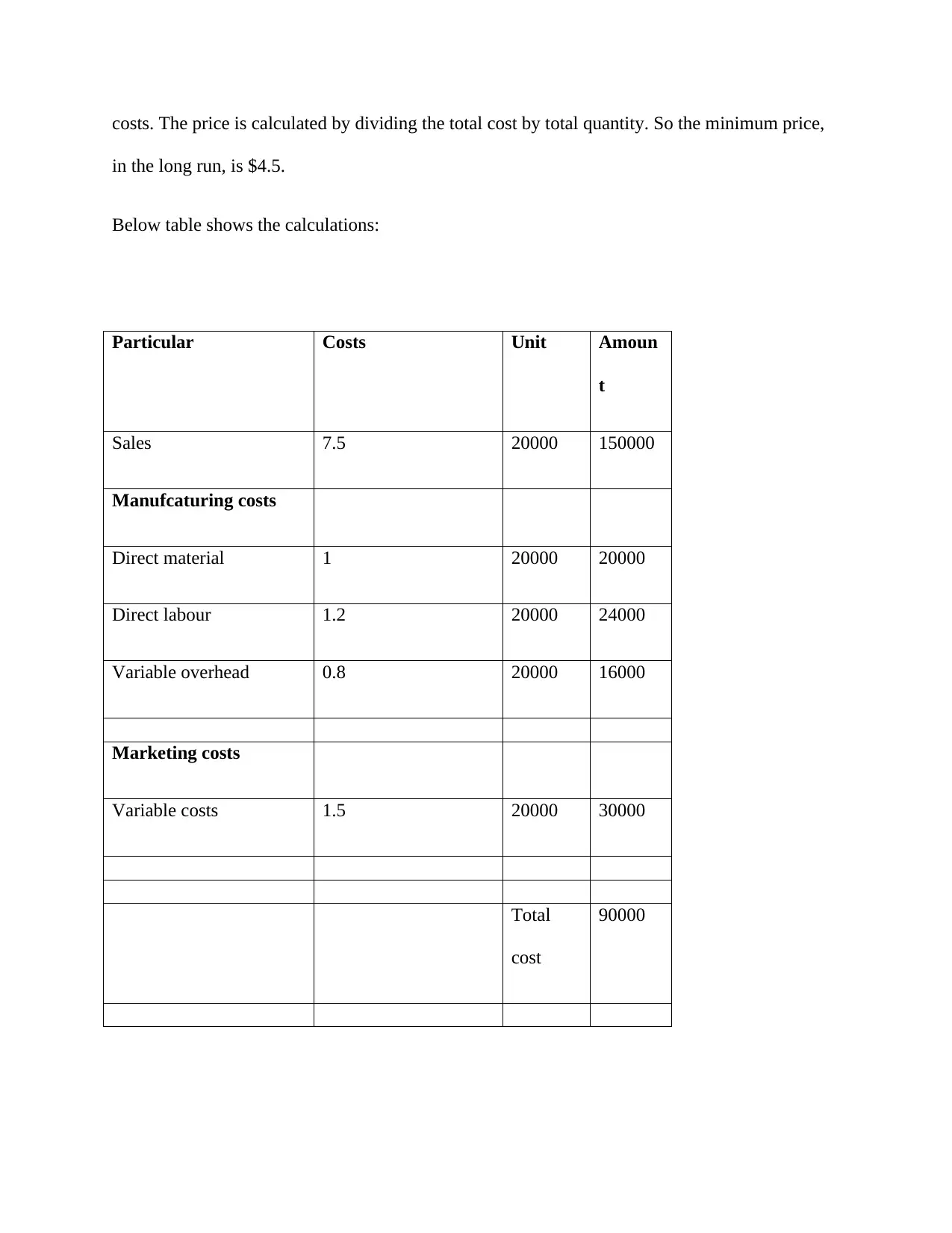
costs. The price is calculated by dividing the total cost by total quantity. So the minimum price,
in the long run, is $4.5.
Below table shows the calculations:
Particular Costs Unit Amoun
t
Sales 7.5 20000 150000
Manufcaturing costs
Direct material 1 20000 20000
Direct labour 1.2 20000 24000
Variable overhead 0.8 20000 16000
Marketing costs
Variable costs 1.5 20000 30000
Total
cost
90000
in the long run, is $4.5.
Below table shows the calculations:
Particular Costs Unit Amoun
t
Sales 7.5 20000 150000
Manufcaturing costs
Direct material 1 20000 20000
Direct labour 1.2 20000 24000
Variable overhead 0.8 20000 16000
Marketing costs
Variable costs 1.5 20000 30000
Total
cost
90000
⊘ This is a preview!⊘
Do you want full access?
Subscribe today to unlock all pages.

Trusted by 1+ million students worldwide
1 out of 14
Related Documents
Your All-in-One AI-Powered Toolkit for Academic Success.
+13062052269
info@desklib.com
Available 24*7 on WhatsApp / Email
![[object Object]](/_next/static/media/star-bottom.7253800d.svg)
Unlock your academic potential
Copyright © 2020–2025 A2Z Services. All Rights Reserved. Developed and managed by ZUCOL.





